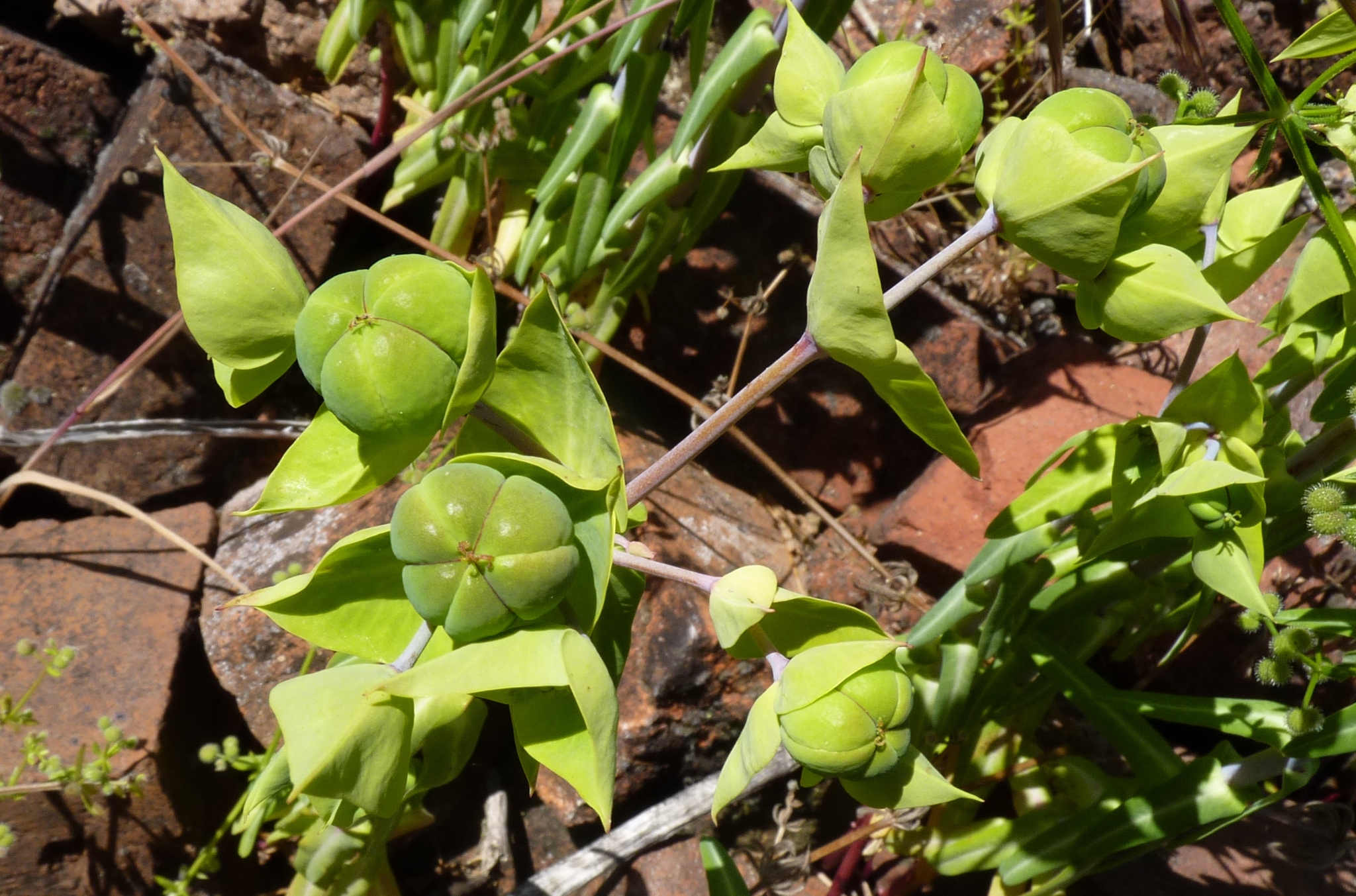
Derived from the name of an African species named by King Juba of Mauritania in the 1st century AD after his Greek physician, Euphorbius, who investigated the medicinal uses of its latex.
Evergreen or deciduous herbs, subshrubs, shrubs or small trees, annual or perennial, sometimes succulent and/or spiny, the stems and foliage with a white latex. Hairs, where present, simple or multicellular. Leaves opposite, alternate or verticillate, stalkless or not, unlobed, penninerved, without glands; margins entire, dentate or lobed; stipules entire, conspicuous, subtended by spiny outgrowths on some succulent species, persistent. The leaves of the flower head may be different in form or size from the stem leaves. Sexes on same or different plants. Flower clusters specialised and referred to as cyathia (see illustration, page 457), axillary, multiple flowers appearing as one, regular, comprising numerous bisexual involucres in dichotomous or umbellate cymes, bracteate (bracts termed cyathophylls); involucres with 4-5 glands alternating with 5 fringed lobes. An individual cyathium consists of several male flowers and 1 female flower enclosed in a cup-like involucre of 5 fused bracts.male flowers stalked or not; calyx lobes absent; petals absent; disc absent; stamens solitary. Female flowers stalked or not; calyx lobes reduced to a low rim; petals absent; disc absent. Ovary 3-chambered, ovules 1 per chamber; styles 3, shortly united at the base, divided into 2. Fruits capsular, dehiscent, 3-lobed, surface smooth. Seeds globose to ellipsoid-ovoid.
Horticulturally and ecologically this is an extremely diverse genus that may be divided into two general groups. First, the warm-climate succulent and often spiny, cactus-like herbs, shrubs or trees; these comprise about 800 or so species. Their interesting forms have made them favourites in specialist nurseries and private collections. Secondly, there are the temperate herbaceous species. These are used in cool-climate borders for their distinctive forms and sometimes for their coloured bracts and foliage. Some of this latter group may tend to naturalise either by self-seeding or by means of their invasive root systems. The Australian climate is not conducive to this temperate group which is not nearly so popular here as in the northern hemisphere.
Care should be taken to avoid naturalisation. Species hybridise freely.
The showy 'flowers' (attractive in floral arrangements) are known botanically as cyathophylls and are, in fact, the structures that surround the true and minute flowers.The white latex exuded by members of this genus is of uncertain function but certainly acts as a deterrent to browsers; it is poisonous to humans when ingested and can cause various irritant skin reactions if applied externally. Bathing in a weak solution of bicarbonate of soda will alleviate this.
Cosmopolitan with perhaps over 2000 species depending on the definition of the genus.About 8 species occur naturally in Australia and about 30 in the segregate genus, Chamaesyce S.F. Gray.
Annuals and perennials by seed, spreading species by division, shrubby species by softwood cuttings. Succulent species may be grown from seed, tip cuttings, or occasionally by grafting. E. pulcherrima is grown from stem-tip cuttings.
There are many medicinal applications. The latex is a coagulant and has been used to heal wounds. E. lathyris has been used as a purgative and has many other medicinal uses.
White latex, flowers clustered in regular cyathia, cyathia with glands 4-5.
White et al. (1941), Moon (1956), Dressler (1962), Carter (1988), Turner & Radcliffe-Smith (1983), Schwartz & LaFon (1983-96), Rauh (1995),Turner (1995a &b).The Euphorbia Journal Vol.1-10 has excellent colour pictures and descriptions of the succulent species.
Source: (2002). Euphorbiaceae. In: . Horticultural Flora of South-eastern Australia. Volume 3. Flowering plants. Dicotyledons. Part 2. The identification of garden and cultivated plants. University of New South Wales Press.
